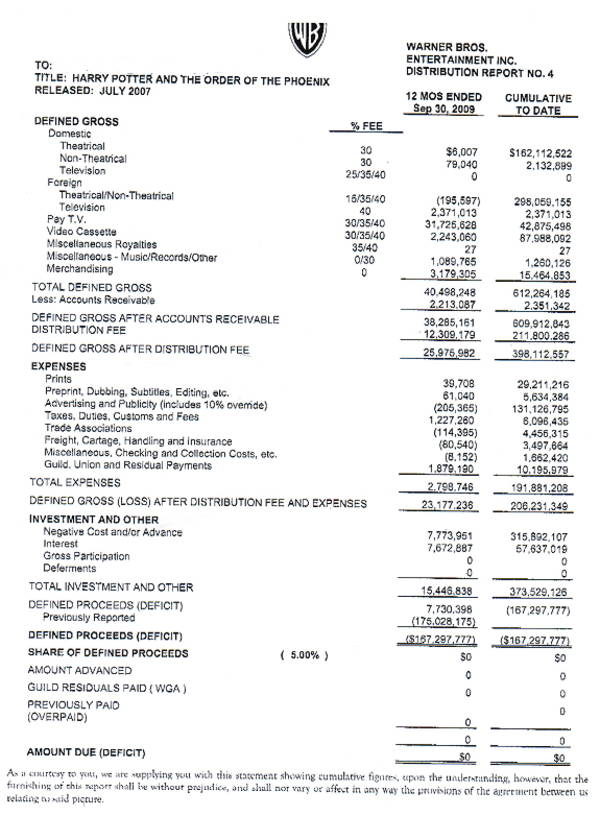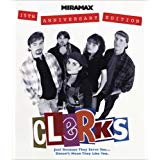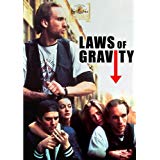> The Budget & Finance Thread
Any available data on a film's budget, especially credible breakdowns, is what's appropriate for this thread.
The idea is to see what others are (reported) to be doing to use as a reference model for what we could/should be doing as a self-check.
"Compared to peer and non-peer filmmakers or the industry, am I spending too much money on X and not enough on Y?"
What got me started on this is that first I had found a reported budget for Lara Croft Tomb Raider: The Cradle of Life
http://abovethelineproducer.blogspot.com/2011/02/film-budgeting.html
"Though movie studios are reluctant to release the precise details of their movies' budgets, it has occasionally been possible to obtain (clandestinely) details of the cost of a films break down.
"Lara Croft Tomb Raider: The Cradle of Life
And that's great and wonderful and all.
Then I find another article that clearly shows the major studios are playing a completely different ball game than many of us in the PONY league.
http://abovethelineproducer.blogspot.com/2010/08/magic-of-studio-financing.html
"Consider Paramount's 2001 action flick Lara Croft: Tomb Raider. On paper, Tomb Raider's budget was $94 million. In fact, the entire movie cost Paramount less than $7 million. How did the studio collect over $87 million before cameras started rolling?
First, they used the German tax-shelter gambit. Loopholes in Germany's tax code are responsible for a good portion of Paramount's profits—an estimated $70 million to $90 million in 2003 alone. Best of all, there's no risk or cost for the studio (other than legal fees)... In the case of Lara Croft: Tomb Raider, Paramount sold the copyright to a group of German investors for $94 million through Tele-München Gruppe, a company headed by German mogul Herbert Kloiber. Paramount then repurchased the film for $83.8 million in lease and option payments. The studio's $10.2 million windfall paid the salaries of star Angelina Jolie ($7.5 million) and the rest of the principal cast.
[Second], Paramount made some more preproduction cash by taking advantage of the British government's largesse. To qualify for Section 48 tax relief in Britain, the movie had to include some scenes filmed in Britain and employ a couple of British actors. Given Lara Croft's peripatetic plot, neither condition presented an artistic problem. Again, Paramount entered into a complex sale-leaseback transaction, this time with Britain's Lombard Bank. Through this legal legerdemain, the studio netted, up front, another $12 million—enough to pay for the director and script.
[Third], To pay for most of the rest of the movie, Paramount sold distribution rights in six countries where the Tomb Raider video games were a big hit with teenage boys. These pre-sales in Japan, Britain, France, Germany, Italy, and Spain brought in another $65 million.
Through this triple play, Paramount earned a grand total of $87.2 million. [Fourth], The remaining budget—less than $7 million—would be covered by licensing the film's U.S. pay-television rights to Showtime (a network owned by Paramount's corporate parent, Viacom). At no cost to its treasury, Paramount launched a potential franchise—don't forget that sequels can be financed with the same "risk management" techniques."
Some of these techniques we might be able to use creative variants of.
Point is, the studios aren't just being dumb and lazy putting up 100% of their own cash outlays and Humpty Dumptying out to the back lot or New Zealand.
Neither should we.
Remainder of budgets available from that article:
"Though movie studios are reluctant to release the precise details of their movies' budgets, it has occasionally been possible to obtain (clandestinely) details of the cost of a films break down.
Terminator 3: Rise of the Machines
Spider-Man
And if you're not paying attention, these are only production budgets/expenses.
They do not include P&A which may easily equal or exceed the production budget ($150m), listed below as "DISTRIBUTION FEE" @ $211.8m and "TOTAL EXPENSES" @ $191.8m (cumulative):

- Major Studio Budgets
- Mini-Major Studio Budgets
- Independent Studio Budgets
- Low Budgets
- Micro Budgets
- No Budgets
- DIY Filmmaker Budgets
Any available data on a film's budget, especially credible breakdowns, is what's appropriate for this thread.
The idea is to see what others are (reported) to be doing to use as a reference model for what we could/should be doing as a self-check.
"Compared to peer and non-peer filmmakers or the industry, am I spending too much money on X and not enough on Y?"
What got me started on this is that first I had found a reported budget for Lara Croft Tomb Raider: The Cradle of Life
http://abovethelineproducer.blogspot.com/2011/02/film-budgeting.html
"Though movie studios are reluctant to release the precise details of their movies' budgets, it has occasionally been possible to obtain (clandestinely) details of the cost of a films break down.
"Lara Croft Tomb Raider: The Cradle of Life
- Story rights and screenplay: $4 million
- Producers: $4 million
- Director (Jan de Bont): $5 million
- Cast: $17.25 million
- - Angelina Jolie: $12 million
- - Extras: $250,000
- - Other (inc. Angelina's perks): $5 million
- Production costs: $67 million
- - Set design and construction: $17.8 million
- Visual Effects: $13 million
- Music: $3.3 million
- Editing: $3 million
- Post Production costs: $1.5 million
Total: $118 million
Source: http://www.edwardjayepstein.com/laracroft1.htm "And that's great and wonderful and all.
Then I find another article that clearly shows the major studios are playing a completely different ball game than many of us in the PONY league.
http://abovethelineproducer.blogspot.com/2010/08/magic-of-studio-financing.html
"Consider Paramount's 2001 action flick Lara Croft: Tomb Raider. On paper, Tomb Raider's budget was $94 million. In fact, the entire movie cost Paramount less than $7 million. How did the studio collect over $87 million before cameras started rolling?
First, they used the German tax-shelter gambit. Loopholes in Germany's tax code are responsible for a good portion of Paramount's profits—an estimated $70 million to $90 million in 2003 alone. Best of all, there's no risk or cost for the studio (other than legal fees)... In the case of Lara Croft: Tomb Raider, Paramount sold the copyright to a group of German investors for $94 million through Tele-München Gruppe, a company headed by German mogul Herbert Kloiber. Paramount then repurchased the film for $83.8 million in lease and option payments. The studio's $10.2 million windfall paid the salaries of star Angelina Jolie ($7.5 million) and the rest of the principal cast.
[Second], Paramount made some more preproduction cash by taking advantage of the British government's largesse. To qualify for Section 48 tax relief in Britain, the movie had to include some scenes filmed in Britain and employ a couple of British actors. Given Lara Croft's peripatetic plot, neither condition presented an artistic problem. Again, Paramount entered into a complex sale-leaseback transaction, this time with Britain's Lombard Bank. Through this legal legerdemain, the studio netted, up front, another $12 million—enough to pay for the director and script.
[Third], To pay for most of the rest of the movie, Paramount sold distribution rights in six countries where the Tomb Raider video games were a big hit with teenage boys. These pre-sales in Japan, Britain, France, Germany, Italy, and Spain brought in another $65 million.
Through this triple play, Paramount earned a grand total of $87.2 million. [Fourth], The remaining budget—less than $7 million—would be covered by licensing the film's U.S. pay-television rights to Showtime (a network owned by Paramount's corporate parent, Viacom). At no cost to its treasury, Paramount launched a potential franchise—don't forget that sequels can be financed with the same "risk management" techniques."
Some of these techniques we might be able to use creative variants of.
Point is, the studios aren't just being dumb and lazy putting up 100% of their own cash outlays and Humpty Dumptying out to the back lot or New Zealand.
Neither should we.
Remainder of budgets available from that article:
"Though movie studios are reluctant to release the precise details of their movies' budgets, it has occasionally been possible to obtain (clandestinely) details of the cost of a films break down.
Terminator 3: Rise of the Machines
- Story rights (Carolco and Gale Anne Hurd): $14.5 million
- Screenplay: $5.2 million
- John D. Brancato & Michael Ferris: $1 million
- Director (Jonathan Mostow): $5 million
- Producers: $10 million
- Cast: $35 million
- - Arnold Schwarzenegger: $29.25 million + 20% gross profits
- - Arnold's perks: $1.5 million
- - Rest of principal cast: $3.85 million
- - Extras: $400,000
- Production costs: $58 million
- Post-production costs: $4 million
- Visual effects: $20 million
- Music: $2 million
- Other costs: $33.6 million
Total: $187.3 million
Source: http://www.edwardjayepstein.com/budget.htmSpider-Man
- Story rights: $20 million
- Screenplay: $10 million
- Producers: $15 million
- Director (Sam Raimi): $10 million
- Cast: $30 million
- - Tobey Maguire: $17 million
- - Kirsten Dunst: $7 million
- - Alfred Molina: $3 million
- - Rest of cast: $3 million
- Production costs: $45 million
- Visual effects: $65 million
- Music: $5 million
- - Composer (Danny Elfman): $2 million.
Total: $200 million
Source: http://www.guardian.co.uk/film/20 "And if you're not paying attention, these are only production budgets/expenses.
They do not include P&A which may easily equal or exceed the production budget ($150m), listed below as "DISTRIBUTION FEE" @ $211.8m and "TOTAL EXPENSES" @ $191.8m (cumulative):

Last edited:



 Some of that looks suspiciously like semantics.
Some of that looks suspiciously like semantics.









 - $1,000
- $1,000










